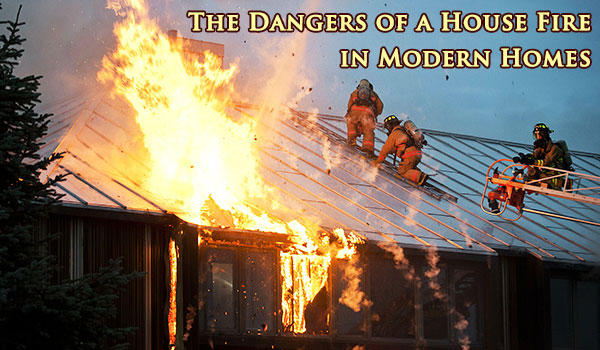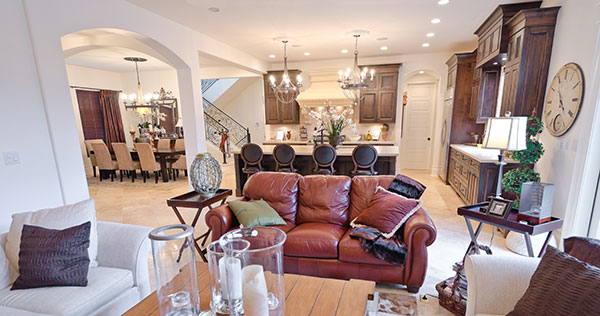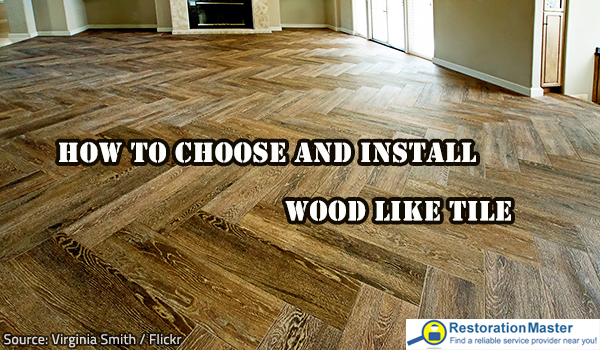The Dangers of a House Fire in Modern Homes
While the number of house fires in the US has been steadily falling during the last several decades, they have become more dangerous than ever before. You may be surprised to learn that the reason for the increased level of danger during a residential fire nowadays is to be found in the construction, design, and furnishing of contemporary buildings.

House fires have become more dangerous than ever before, causing severe property damage and posing great risks to the lives of the occupants of the building and the firefighters who come to their rescue.
Even though modern homes are built to the latest fire safety codes and include various fire safety features, they actually burn much faster and more violently than older houses. The intensity of the fire is due to the specifics of modern-day construction materials, contemporary home layouts, and common household materials.
Building Materials
New building techniques typically use engineered building materials instead of the traditional wood and bricks. These modern construction materials have a number of considerable advantages – they are eco-friendly, light-weight, durable, inexpensive, and easy to work with – but they also present a lot of fire safety challenges because of their composition and reaction to heat.
Engineered lumber, plywood, and oriented strand board (the most commonly used materials for siding, roofing and flooring in contemporary lightweight constructions) are made from wood chips, sawdust, and glue. During the manufacturing process, the wooden strands are compressed with formaldehyde-based resins and wax for added strength. Those materials, however, make the final product extremely flammable. It burns so quickly that its flames can destabilize the structural components of a home and cause them to collapse within minutes. In comparison, it takes about 20 minutes for legacy materials (such as solid wood structures) to collapse. Besides, the wall linings in modern homes are thinner than those in older buildings and therefore – more easily penetrated by fire.

The open floor plan in contemporary homes contributes a lot to the quick spread of a house fire.
The highly flammable engineered construction materials, however, are not the only reason why modern homes burn faster. It is the open floor plans and the synthetic household furnishings that “fuel the fire” and increase the risks it poses.
Open Space Layout
The ever more popular open space layout makes homes very vulnerable to fire damage.
When a fire starts in one room, the walls and doors help contain the spread of flames and limit fire and smoke damage to the rest of the property. Therefore, compartmentalization is believed to be essential for fire protection. When walls no longer separate rooms, however, as is the case with contemporary open layouts, there is nothing to contain the fire and it spreads quickly and easily throughout the home.
What’s more, the large open space provides huge volumes of air that further fuel a fire, increasing its intensity and destructive power. So, it is the open floor plan in contemporary homes that provides the ample amounts of space and oxygenOxygen is a chemical element essential for combustion and li... More required for a small flame to quickly spread out of control and cause extensive damage.
Thermal Windows
Contemporary homes are usually built with energy-efficient windows to help insulate the building and reduce heating and cooling costs. During a fire, however, the extreme temperatures quickly melt the vinylVinyl is a durable synthetic plastic material commonly used ... More sashes and frames of thermal windows. The window glass breaks and outside air rushes into the house causing the fire to reach flashover – the point at which most of the combustible materials in the room reach their auto ignition temperature and start burning and emitting flammable gases.

Some of the modern energy-saving features in contemporary homes pose unexpected fire safety challenges.
Single-pane wood-frame windows, on the other hand, retain their integrity much longer than modern energy-efficient windows. Therefore, the dangerous flashover effect is delayed, allowing the people in the building more time to evacuate and giving the firefighters a better chance to extinguish the flames before they have caused irreversible damage.
Besides, thermal windows can actually contribute to the risk of house fires because of their reflective qualities. They can reflect sunlight onto other homes with such a great intensity that the vinylVinyl is a durable synthetic plastic material commonly used ... More siding may start to melt and the cedar shingles may easily catch fire.
Synthetic Furnishings
Even though all of the above factors contribute to the quicker spread and the more destructive effect of house fires in modern homes, the greatest danger comes from the synthetic materials used in contemporary furnishings.
Older furniture was made from solid wood; the upholstery was stuffed with cotton and covered with leather, wool, linen, or silk; carpets and drapes were crafted from natural fabrics; and so on. Nowadays, wood frames and trims are manufactured from composites and traditional paddings are replaced with polyurethane foam. Almost all carpeting has a synthetic backing and the curtains contain synthetic blends. These synthetic materials burn much quicker than their legacy counterparts, accounting for violent house fires, severe property damage, and even death. Plastic (one of the most commonly used materials in contemporary household products), for example, burns as quickly as gasoline when it catches fire. Besides, it produces thick, dark smoke that is full of harmful chemicals released from the synthetic materials. The resulting toxic environment may leadLead is a heavy metal that can be toxic to humans, especiall... More to casualties, even if the building retains its integrity and the flames never reach the residents.
30 years ago, you would have about 15-20 minutes to evacuate the building in the event of a house fire. Today, escape time is reduced to no more than three or four minutes. Firefighters face much more difficulties as well – they have less time to react and the risk for their lives is considerably higher. Besides, proven firefighting techniques are no longer efficient because of the new challenges.

Synthetic materials burn quickly and release harmful chemicals, further increasing the dangers of a house fire in modern homes.
However great the dangers of a house fire in modern homes, making informed decisions about the furnishings and interiors and practicing some proven fire safety strategies will ensure a certain level of protection and will help prevent structural failure and fatalities. Make sure you know how to use fire safety equipment – smoke alarms, portable fire extinguishers, etc., and practice evacuation drills with your family several times a year.
Good to remember: The most efficient fire preventionPrevention refers to actions taken to reduce the likelihood ... More measure in modern homes is installing fire sprinklers on strategic places throughout the property. Home fire sprinklers can douse a fire or control it until the firefighters arrives, preventing severe damage and protecting lives.
In the unfortunate event of a house fire, make sure you call a professional fire damage restoration company as soon as the flames have been extinguished. The experts will be able to prevent smoke and sootSoot is fine black particles composed of carbon and other ma... More from causing further damage and will salvage as much of your property as possible. Your home will be restored in a quick and efficient manner and you will be able to resume your normal life soon after the disaster.












